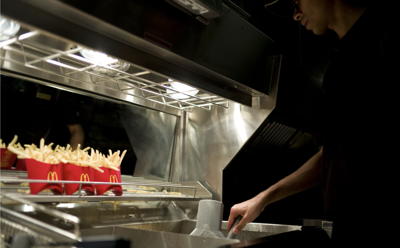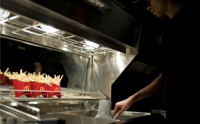Earlier this year, a viral TikTok trend claimed a meal of McDonald’s fries and a full-sugar Coke could cure a migraine.
The McDonald‚Äôs migraine hack, also known as the ‚ÄúMcMigraine,‚Ä̬†is just one example of do-it-yourself medicine, a trend toward alternative or homemade treatments based on advertising or social media trends.
In a recent webinar, the Ontario Medical Association said patients should always verify any medical advice they find online from non-medical sources. Unproven therapies can lead to misdiagnosis and poor health outcomes, the OMA warns.
Social media trends
Dr. Zainab Abdurrahman, president of the Ontario Medical Association, said family doctors have seen a rise in patients turning to TikTok videos, online diagnosis and unproven therapies for treatment of various health concerns. 
According to the¬†, a migraine is more than just a bad headache ‚ÄĒ it can cause debilitating, throbbing, one-sided head pain that can leave a patient in bed for days.
Abdurrahman said while caffeine can be used to treat migraines in some people, it can also trigger pain in others. Salt may help to relieve migraine pain in some patients, but in others it could make the problem worse.
‚ÄúSo I can understand why they‚Äôre perhaps talking about fries and a Coke in that kind of context,‚ÄĚ said Abdurrahman. ‚ÄúBut the thing is, you actually want to have the conversation. So whoever is treating your migraines ‚ÄĒ if you‚Äôre talking to your family doctor or your headache specialist or your urologist ‚ÄĒ they can talk about how food is playing a role in your migraine. Ask about what foods you should avoid and which foods could be helpful when experiencing a migraine.‚ÄĚ
Why patients seek advice from Dr. Google
Abdurrahman, an allergist and clinical immunologist, said patients may have valid reasons for wanting to take their care into their own hands. Lack of access to physician care, an inability to take time away from work or caregiver responsibilities for other family members may prevent patients from seeking advice from a qualified physician.
Fear or lack of trust in the medical profession can also lead patients toward do-it-yourself medicine with mixed results at best.
‚ÄúWhen patients take health into their own hands and they actually implement some of these do-it-yourself treatments or remedies, unfortunately there are often consequences. The treatments may not actually help alleviate the symptoms that they‚Äôre looking for help on, or help with the disease or prevent a certain disease,‚ÄĚ said Abdurrahman.
In some cases, unproven treatments from a web search or social media can cause unnecessary harms or prolong symptoms and delay patients from getting proper care, Abdurrahman added.
DIY medicine trends
Dr. Valerie Primeau, a North Bay psychiatrist, has noticed an increase in self-diagnosis for mental health concerns. Primeau said parents may claim their child has attention deficit hyperactivity disorder (ADHD) using an online diagnosis tool or a TikTok video. It’s not hard to find various social media influencers or non-healthcare providers that will provide a video and encourage viewers to see if they have ADHD symptoms, for example.
While some of the influencers may be actual physicians, many are not, Primeau said.
Some online tests may market themselves as being accurate to diagnose disorders like ADHD, but Primeau said patients may face risks when using these self-diagnostic tools.
Certain disorders, like bipolar disorder, can have a high risk of misdiagnosis, said Primeau.
‚ÄúWhen studies have looked at videos on social media, a lot of them are overly generalized, meaning they don‚Äôt usually target a particular disorder even though they say they do,‚ÄĚ said Primeau. ‚ÄúThey may portray inaccurately the illnesses or provide misleading information.‚ÄĚ
Patients who misdiagnose themselves could try medication that hasn’t been prescribed to them from a friend or family member, leading to harmful side effects, Primeau added. Online diagnosis tools can also raise concerns for privacy and security.
Your phone may be feeding you bad advice
Dr. Alyse Goldberg, a Toronto endocrinologist, noted your smartphone may be listening to you through a virtual assistant or voice commands and could recommend personalized ads based on your health symptoms.
Your phone might suggest health and lifestyle tips, like what to do for bloating, anxiety or brain fog, for example.
‚ÄúYou get targeted in terms of what therapeutic options a physician may be giving you, but then reasons to avoid evidence-based treatment,‚ÄĚ Goldberg said.
Patients could also be bombarded with non-medical or non-evidence-based therapies, like tea supplements to reduce testosterone levels or unproven weight loss treatments.
Phrases like ‚Äúthis has been hidden from you‚ÄĚ or ‚Äúnever before seen‚ÄĚ can lead to questionable information and unproven treatments.
Patients who pursue DIY health care trends may place themselves at greater risk by delaying potential life-saving care.
Dangers of alternative cancer treatments
Dr. David D’Souza, a London-based radiation oncologist, said patients facing a cancer diagnosis may look to social media for advice.
‚ÄúSome of the things that get portrayed, especially for cancer treatments, that appeal to people are things that are all-natural, or come with very few unpleasant side effects or they offer miraculous outcomes,‚ÄĚ he said.
D’Souza said a study examining popular social media posts about cancer between 2018 and 2019 found one third of the entries had false, inaccurate or misleading information.
‚ÄúMost of them are potentially harmful,‚ÄĚ said D‚ÄôSouza.
Providing examples from his own practice, D’Souza said inaccurate social media advice can lead to delays in seeking treatment for potentially curable cancer.
One of D’Souza’s patients, a young woman diagnosed with cervical cancer, wasn’t ready to accept conventional treatment and decided to pursue other remedies. When she returned two years later, her disease had progressed.
‚ÄúUnfortunately, our ability to control and give her a good outcome was severely compromised,‚ÄĚ said D‚ÄôSouza.
In some cases, DIY medicine can be outright dangerous. D’Souza had a patient with a nephrostomy tube in their kidney used as part of a cancer treatment plan. The patient attempted to use a piece of twine from a weed trimmer to remove sludge from the tube. The patient also asked about using Lysol disinfectant to clean the tube.
More recently, D’Souza met with a patient who got a second opinion from Johns Hopkins University, but refused key parts of her treatment and drove two hours for hypothermia treatments and tried taking intravenous ivermectin instead of conventional cancer treatment.
D’Souza has also heard about patients who inject cannabis oil on a tumour, another unproven and potentially harmful technique.
How to identify reputable information
Primeau said identifying fact-based information isn’t always straightforward, especially for people who lack a medical background. Patients should look for videos posted by health care providers or official agencies like the Ontario Medical Association.
‚ÄúI always recommend, just bring what you found to your primary care provider or professional if you‚Äôre able to, to make sure you can tell what is appropriate and what isn‚Äôt,‚ÄĚ said Primeau.
Error! Sorry, there was an error processing your request.
There was a problem with the recaptcha. Please try again.
You may unsubscribe at any time. By signing up, you agree to our and . This site is protected by reCAPTCHA and the Google and apply.
Want more of the latest from us? Sign up for more at our newsletter page.





















To join the conversation set a first and last name in your user profile.
Sign in or register for free to join the Conversation